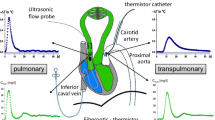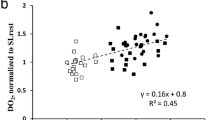Abstract
Adenosine, an endogenous nucleoside, is released by hypoxic tissue, causes vasodilation, and influences ventilation. Its effects are mediated by P1-purinoceptors. We examined to what extent the plasma adenosine concentration in the peripheral venous blood correlates with hypoxic ventilatory response (HVR) and ventilatory drive P0.1 to find out whether endogenously formed adenosine has an influence on the individual ventilatory drive under hypoxic conditions. While investigating the HVR of 14 healthy subjects, the ventilatory drive P0.1 was measured with the shutter of a spirometer. Determination of the ventilatory drive P0.1(RA) started under room air conditions (21% O2) and then inspiratory gas was changed to a hypoxic mixture of 10% O2in N2to determine P0.1(Hyp). At the time of the P0.1 measurements, two blood samples were taken to determine the adenosine concentrations. After removal of cellular components and proteins, samples were analyzed by high-pressure liquid chromatography (HPLC). Both adenosine concentrations in plasma under room air (r = 0.59, p< 0.05) and adenosine concentrations under hypoxia (r = 0.75, p< 0.01) correlated significantly with the ventilatory drive P0.1. In addition, plasma adenosine concentrations during hypoxic conditions showed a significant correlation with HVR on the 0.01 level (r = 0.71, p< 0.01). The results indicate a possible role of endogenous adenosine in the regulation of breathing in humans. We assume that endogenous adenosine influences the HVR and the ventilatory drive, probably by modulating the carotid body chemoreceptor response to hypoxia.
Similar content being viewed by others
References
Möser GH, Schrader J, Deussen A. Turnover of adenosine in plasma of human and dog blood. Am J Physiol 1989;256(4 Pt 1):C799–C806
Kobayashi S, Zimmermann H, Millhorn DE. Chronic hypoxia enhances adenosine release in rat PC12 cells by altering adenosine metabolism and membrane transport. J Neurochem 2000;74:621–632
Huszár É, Barát E, Kollai M. Isocratic high-performance liquid chromatographic determination of plasma adenosine. Chromatographia 1996;42:318–322
Jonzon B. Adenosine Mechanisms in the Central Nervous System [doctoral thesis]Stockholm, Sweden Karolinska Institute 1984 1021
Bryan PT, Marshall JM. Adenosine receptor subtypes and vasodilatation in rat skeletal muscle during systemic hypoxia: a role for A1 receptors. J Physiol 1999;514:151–162
Coney AM, Marshall JM. Role of adenosine and its receptors in the vasodilatation induced in the cerebral cortex of the rat by systemic hypoxia. J Physiol 1998;509:507–518
Georgopoulos D, Holthby SG, Berezanski D, Anthonisen NR. Aminophylline effects on ventilatory response to hypoxia and hyperoxia in normal adults. J Appl Physiol 1989;67:1150–1156
Gleeson K, Zwillich CW. Adenosine infusion and periodic breathing during sleep. J Appl Physiol 1992;72:1004–1009
Reid PG, Watt AH, Penny WJ, Newby AC, Smith AP, Routledge PA. Plasma adenosine concentrations during adenosine-induced respiratory stimulation in man. Eur J Clin Pharmacol 1991;40:175–180
Smits P, Schouten J, Thien TH. Respiratory stimulant effects of adenosine in man after caffeine and enprofylline. Br J Clin Pharmacol 1987;24:816–819
Saito H, Nishimura M, Shinano H et al. Plasma concentration of adenosine during normoxia and moderate hypoxia in humans. Am J Respir Crit Care Med 1999;159:1014–1018
Easton PA, Slykerman LJ, Anthonisen NR. Ventilatory response to sustained hypoxia in normal adults. J Appl Physiol 1986;61:906–911
Bärtsch P, Grünig E, Hohenhaus E, Dehnert C. Assessment of high altitude tolerance in healthy individuals. High Alt Med Biol 2001;2:287–296
Hirshman CA, McCullough RE, Weil JV. Normal values for hypoxic and hypercapnic ventilatory drive in man. J Appl Physiol 1975;38:1095–1098
Hohenhaus E, Paul A, McCullough RE, Kücherer H, Bärtsch P. Ventilatory and pulmonary vascular response to hypoxia and susceptibility to high altitude pulmonary oedema. Eur Respir J 1995;8:1825–1833
van Klaveren RJ, Demedts M. Determinants of the hypercapnic and hypoxic response in normal man. Respir Physiol 1998;113:157–165
Matsuzawa Y, Fujimoto K, Kobayashi T et al. Blunted hypoxic ventilatory drive in subjects susceptible to high-altitude pulmonary edema. J Appl Physiol 1989;66:1152–1157
Milledge JS, Thomas PS, Beeley JM, English JSC. Hypoxic ventilatory response and acute mountain sickness. Eur Respir J 1988;1:948–951
Nishimura M, Yamamoto M, Yoshioka A, Akiyama Y, Kishi F, Kawakami Y. Longitudinal analyses of respiratory chemosensitivity in normal subjects. Am Rev Respir Dis 1991;143:1278–1281
Sahn SA, Zwillich CW, Dick N, McCullough RE, Lakshminarayan S, Weil JV. Variability of ventilatory responses to hypoxia and hypercapnia. J Appl Physiol 1977;43:1019–1025
West JB. Rate of ventilatory acclimatization to extreme altitude. Respir Physiol 1988;74:323–333
Hackett PH, Roach RC, Schoene RB, Harrison GL, Mills WJ. Abnormal control of ventilation in high-altitude pulmonary edema. J Appl Physiol 1988;64:1268–1272
Insalaco G, Romano S, Salvaggio A et al. Cardiovascular and ventilatory response to isocapnic hypoxia at sea level and at 5050 m. J Appl Physiol 1996;80:1724–1730
Sugimori K, Amin HM, Esposito BF, Seedat MS, Camporesi EM. Effect of slow versus fast desaturation on the ventilatory response to hypoxia. J Med 1996;27:277–292
Milic-Emili J, Whitelaw WA, Derenne JP. New tests to assess lung function: occlusion pressure—a simple measure of the respiratory center’s output. N Engl J Med 1975;293:1029–1030
Whitelaw WA, Derenne JP, Millic-Emili J. Occlusion pressure as a measure of respiratory center output in conscious man. Respir Physiol 1975;23:181–199
Honda Y. Ventilatory depression during mild hypoxia in adult humans. Jpn J Physiol 1995;45:947–959
Moore LG, Harrison GL, McCullough RE et al. Low acute hypoxic ventilatory response and hypoxic depression in acute altitude sickness. J Appl Physiol 1986;60:1407–1412
Sato M, Severinghaus JW, Bickler P. Time course of augmentation and depression of hypoxic ventilatory responses at altitude. J Appl Physiol 1994;77:313–316
Maxwell DL, Fuller RW, Nolop KB, Dixon CMS, Hughes MB. Effects of adenosine on ventilatory responses to hypoxia and hypercapnia. J Appl Physiol 1986;61:1762–1766
Parsons ST, Griffiths TL, Christie JML, Holgate ST. Effect of theophylline and dipyridamole on the respiratory response to isocapnic hypoxia in normal subjects. Clin Sci Lond 1991;80:107–112
Watt AH, Routledge PA. Adenosine stimulates respiration in man. Br J Clin Pharmacol 1985;20:503–506
Johnson TS, Rock PB. Acute mountain sickness. N Engl J Med 1988;319:841–845
Griffiths TL, Christie JML, Parsons ST, Holgate ST. The effect of dipyridamole and theophylline on hypercapnic ventilatory responses: the role of adenosine. Eur Respir J 1997;10:156–160
Author information
Authors and Affiliations
Corresponding author
Rights and permissions
About this article
Cite this article
Drumm, D., Hoefer, M., Juhász, J. et al. Plasma Adenosine during Investigation of Hypoxic Ventilatory Response. Sleep Breath 8, 31–41 (2004). https://doi.org/10.1007/s11325-004-0031-5
Issue Date:
DOI: https://doi.org/10.1007/s11325-004-0031-5




